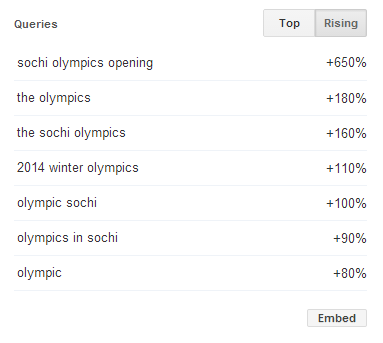
Facebook recently acquired a company called WhatsApp for $19 billion dollars. Continue reading “Facebook Buys WhatsApp for $19 Billion”

Facebook recently acquired a company called WhatsApp for $19 billion dollars. Continue reading “Facebook Buys WhatsApp for $19 Billion”

In this post we’ll be covering Google Search and YouTube Trends, and how to use the free tools provided by Google to understand trends across the web. Understanding trends can be valuable for several reasons. Not the least of which is finding those topics people are now (even those they will be) interested in.
By using information about trends we can match marketing campaigns to trending topics of interest. These topics can even be narrowed down to the metropolitan area for some searches. Here we’ll focus on the value to content marketers specifically. This information will also be valuable to online marketers more broadly. We’ll cover how to target products and services in marketing campaigns using trends information.

To begin with, the Search trends tool is available at google.com/trends. What you’ll see is a dashboard with several features, and a lot of information. In the bottom left, click on the colorful boxes to see a full screen live version of Google Search terms. Top left of this screen allows you to expand the number of searches you see on screen at the same time. This view gives you a kind of real time look of the current searches for any region globally.

Going back to the main dashboard, click over on the right on “Explore In-Depth” to see the real magic. Now enter a search term, for example, “Sochi olympics”. Right off the bat you’ll see that Canada, and countries to the north, are more interested in these games than anywhere else. Likely because these are winter games.
Here you can also narrow your search by time or region. Click on the “Regional interest” graphic to drill right down into this data. Often you can see interest in your chosen topic on a granular level like a metropolitan area. Using this information helps us to target our message to specific geographic regions. You’ll also find that you can view this interest over time, which looks a bit like viewing a weather radar. Like weather patterns, use trends to help predict what topics will be of interest to people.

Below “Regional interest” you’ll see “Related searches”. Here you can find related topics to your search term, and you can see specific queries that people are using related to your topic. One of the best features, we think, is in this queries section. Click, “Rising” to see those queries that are rising in popularity.
Rising query information can help you match your message with a topic that is growing in interest. The idea here is to meet supply with demand as it peaks. There’s nothing worse than writing about a topic that is “so last week”. In our example, as of this writing, we see that the area of most interest is surrounding the opening ceremony.

You can change the trends search from “Web search” to “YouTube search.” Doing this you’ll find detailed information about what people are searching for on YouTube. If you’d like to explore YouTube trend data more in depth there’s a YouTube trends dashboard. A great benefit to the YouTube trends dashboard is the ability to break down results by demographic data. So for example you can see what males between 18-24 find most interesting.
One of the most interesting features to YouTube trends is the ability to switch from “most viewed” to “most shared”. Breaking down the results by “most shared” shows you what topics are going to be popular soon. For example, I filtered YouTube videos by males, in the United States, between 25-34, sorted by “most shared”. I found this video, “ANCHOR CONFUSES SAMUEL L. JACKSON WITH LAURENCE FISHBURNE LIVE ON AIR KTLA” which had about 600k views. The next day that same video had almost 1.5 million views. Using YouTube trends I was able to accurately predict what would be a hot video the next day.

The Sochi 2014 Winter Olympics are well underway. The US has already medaled in several events for a total of 5 as of this writing. This is two behind the Netherlands and Norway, who each have 7 so far.
Aside from all the medals being won, there is a lot of technology going on behind the scenes at these Olympic games. Many of us may remember the swim suit that led to several world record breaking performances in 2008. This was the LZR Racer manufactured by Speedo. This suit was banned from use by FINA (the international governing body of swimming) in 2009.
This year the U.S. Speedskating team is pushing the boundaries again. This time with a new suit developed by a joint venture between Under Armour and Lockheed Martin. The result of this venture is the Under Armour Mach 39 Speedskating Skin. According to Kevin Haley, senior vice president of innovation at Under Armour:
“By partnering with Lockheed Martin we brought in an organization with 60,000 engineers. Although we don’t need all 60,000, they have the right experts to do modeling and fluid dynamics off motion-capture filming. There is a level of expertise and brain power that has never been dedicated to a uniform before.” (Sports Illustrated)
There has also been a lot of talk surrounding the security of these Olympic games, and the technology being employed to ensure a safe event has never been more powerful. According to The Guardian a team of Russian investigative journalists found that, “Russia’s powerful FSB security service plans to ensure that no communication by competitors or spectators goes unmonitored during the event”.
Not only is the Russian government going to be monitoring every piece of communication during the games, but they are also employing systems to monitor that traffic automatically by tracking keywords, “deep packet inspection, which allows intelligence agencies to filter users by particular keywords, is being installed across Russia’s networks”. (The Guardian)
Often, unmanned aerial vehicles (UAVs) or drones have a bad reputation for being used in a military setting. However at the Sochi Winter Olympics there is drone technology being used for a much less sinister purpose. This year, for the first time, we’re getting live TV footage from the Olympic slopes from a camera drone.
These drones use multiple rotors, and look a bit like a flying spyder. They are much less expensive to operate than more traditional helicopters, and they can capture footage helicopters can’t because they can get closer to the action. Some people have raised concerns over whether these drones are safe to fly near people according to this AP article on Fox
“chances of drone crashes are close to zero when a drone is handled by an experienced pilot, because the drones are programmed to return to base at the slightest problem — such as a low battery, rough winds or a malfunction.”
From new skating skin, to surveillance technology, to new ways of capturing the action for TV audiences, the Sochi 2014 Winter Olympics are full of the latest technology.

Business strategy is more complicated than three simple steps, but you can encapsulate the basic movement of business planning by looking at it in three general phases.
Perhaps in the future we will look in deeper detail at some of the specifics in each of the three steps, but for now we will end our long stretching series with the final general step – Evaluation.
The earlier articles (for your reference) may be found here:
By way of review: the first general step in business strategy is formulating the strategy itself. The second step is then the process of implementation. Once you have drawn up a comprehensive plan and put it in place, the final stage, evaluation, is one of maintenance.
Businesses cannot simply put a plan into place and expect it to run itself. As with any plan in any field, business strategies must be constantly evaluated. Some of the important questions to ask include –
Every aspect of the plan must be tracked and scrutinized. This will allow the business owner to make the necessary adjustments in strategy and implementation to fine tune the overall plan and make it what the boardroom envisioned. Just be careful – constant evaluation does not mean literally every day. A plan must have time to come together and have effect. Depending on your business, this could be anywhere between several weeks and several months.
Once you have allowed sufficient time to pass, and gathered enough data to get a good idea of the impact of your new business strategy, it is time to determine what, if anything, to modify. Again, this could run from one extreme to the other: from barely changing anything at all, to throwing the new strategy out in its entirety and beginning again from scratch.
If the plan was formulated properly, it should not need to be wholly tossed, but rather modified to one extent or another. No matter how much time and research and money and effort go into formulation and implementation, no business strategy is perfect. You can always find things to make better. Always. Be humble enough to see the holes in your initial plan, and then do due diligence to determine the best way to fix the problems.
This evaluation stage is never ending for a well run business. You should always be evaluating the plan you have in place, formulating ways to make it better, and implementing those improvements. So the general cycle repeats itself over and over again, and with each repetition, your business strategy is coming ever closer to meeting your initial goals (unless you determine those goals are the thing that needs changing!).
Formulation – invest the needed time and money to evaluate where your company is now, set both short and long-term goals, and draw up a good strategy for achieving those goals.
Implementation – put your plan into action. This may require anything from new training to new products, and often requires new advertising and approaches to make this step successful.
Evaluation – use any tools and data you have at your disposal to determine how closely the implementation of your business strategy is matching the formulated vision. Tweak, re-implement, and repeat.
Dr. William R. Boulton has provided an excellent resource which comments on the steps of Business Strategy from a slightly different angle, and which is definitely worth your time – Strategic Analysis Model. [http://www.auburn.edu/~boultwr/html/strategic_analysis_model.htm]

For years now content marketing has been the talk of the town so to speak, and 2014 is in many ways no different. Content is still king, and a content marketing strategy is essential for doing well in Google Search. Continue reading “Content Marketing in 2014”